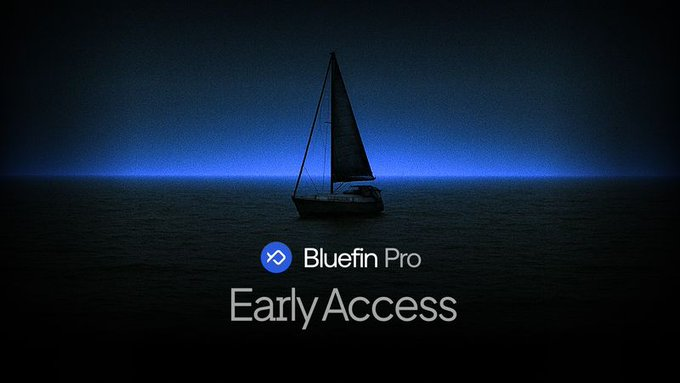Core Positioning and Project Evolution of Bluefin
Bluefin (BLUE) is a decentralized derivatives trading protocol built on the Sui blockchain, launched by Bluefin Foundation in 2024. In its early stage, the project focused on filling the gap in institutional-grade derivatives trading within high-performance blockchain ecosystems, attracting users with products such as perpetual contracts and spot trading. A key turning point came on May 14, 2025, when its governance token BLUE was listed on Binance’s Alpha platform. Backed by $80 million in liquidity support from Jump Trading, the first-day trading volume exceeded $18 million. Blue differentiates itself through technical performance, user experience, and institutional-grade liquidity.

This Token Insights article delves into how Bluefin accelerates the development of derivatives trading in the Sui ecosystem through high-performance architecture and tokenomics, and assesses its long-term impact on the DeFi market.
Leveraging Sui’s Narwhal-Bullshark consensus mechanism, Blue achieves processing capacity of over 10,000 transactions per second (TPS), while reducing gas fees to $0.0001. This high-performance setup enables support for high-frequency trading strategies, such as millisecond-level quote updates by market makers. In terms of user experience, Blue introduces a wallet-free trading model, allowing users to trade directly via email or social media accounts. Private keys are managed using Multi-Party Computation (MPC) technology, significantly lowering entry barriers for Web2 users. On the liquidity side, top market makers such as Wintermute and Keyrock participate deeply, bringing order book depth and slippage control close to levels seen on mainstream centralized exchanges.
Technological Innovation and Market Competitiveness
Bluefin’s technical architecture is built around Sui’s high-throughput capabilities, with core features including perpetual contracts, a smart routing system, and a dynamic insurance fund. Its hybrid liquidity model integrates on-chain AMMs with traditional market maker quotes. For example, slippage for the BTC/USDT pair is kept under 0.5%, significantly outperforming similar protocols. The dynamic insurance fund mechanism allocates 5% of protocol revenue to compensate users for losses caused by extreme market conditions. As of 2025, the fund had paid out over $12 million, strengthening user confidence in fund safety.
Market data validates Blue’s competitiveness: its liquidation risk for perpetual contracts is 30% lower than that of similar protocols, average user transaction latency is just 1.2 seconds, close to CEXs like Binance. Total value locked (TVL) on-chain grew from $80 million to $319 million within three months, accounting for 72% of the Sui ecosystem’s derivatives market. The launch of cross-chain margin functionality further attracted holders of multi-chain assets, allowing users to collateralize assets like ETH and SOL to participate in Sui ecosystem trading, thereby improving capital efficiency.
Tokenomics and Potential Risks
The total supply of BLUE tokens is 1 billion, with the following distribution: 45% for community incentives, 20% for the team (4-year vesting), 15% for investors, and 20% reserved in the treasury for ecosystem expansion. The token’s utilities include governance voting, revenue sharing, and trading fee discounts. By staking BLUE, users can participate in governance decisions such as fee rate optimization and voting on new asset listings. 20% of protocol revenue is distributed to stakers, with an estimated annual yield of around 15%. Users holding over 1,000 BLUE tokens can enjoy up to 30% trading fee discounts.
After its launch on Binance Alpha, BLUE’s price rose 16% within 24 hours. However, two major risks should be noted: first, investor tokens will start unlocking in batches from Q3 2025, potentially creating short-term sell pressure; second, 72% of trading volume is concentrated on the Sui chain, and cross-chain expansion capabilities remain unproven. Additionally, protocols like Hyperliquid already occupy 60% of the derivatives market share, meaning Blue must continue innovating to stay competitive. Investors can track real-time staking data and price movements via the JuCoin market page to adjust strategies accordingly.
Future Challenges and Strategic Layout
Bluefin faces dual competition from CEXs and similar DEXs. On the technical side, it must address fragmented liquidity across multi-chain assets — for example, asset interoperability between Ethereum and Solana ecosystems has yet to be achieved. On the regulatory front, scrutiny from the U.S. SEC over derivatives protocols may restrict anonymous access features, forcing Blue to adjust its market strategy.
Next steps focus on product upgrades and global expansion. In Q3 2025, Blue will launch an options trading module supporting multi-asset collateral and portfolio strategies. A compliant fiat on/off ramp, developed in collaboration with RedotPay, is expected to go live within the year, with a focus on expansion in Southeast Asia and the Middle East. On the user acquisition side, localized campaigns and educational content will reduce onboarding costs for Web2 users. If Blue can continue to optimize trading depth and expand multi-chain support, it may become a leading protocol in the derivatives space. As stated in its whitepaper: “When on-chain experiences break through performance bottlenecks, DeFi will redefine financial infrastructure.”





